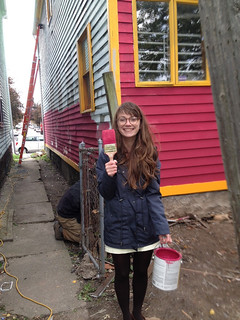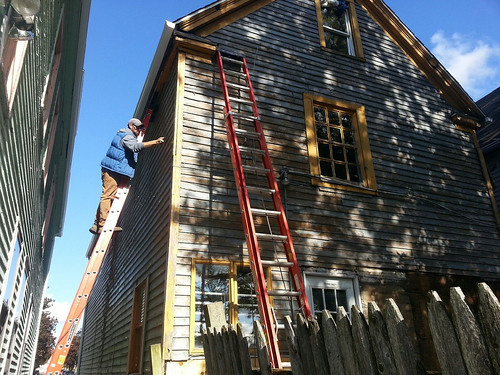Saving older houses from the "vacancy vortex," a little at a time

Posted November 13, 2013 at 1:16PM
Nearly every big American city suffers from vacant and abandoned properties. The mass migration of population to the suburbs in the second half of the 20th century was devastating to neighborhoods left behind, resulting in declining central-city populations that in almost all cases remain below historic levels today. Some cities and neighborhoods are finally starting to rebound with new population growth, and some have developed innovative programs to accelerate recovery and rehabilitation of abandoned properties. The pace of recovery is uneven at best, however, and neighborhood restoration is especially challenging in slow- or no-growth metros.
This results in what independent Buffalo developer Bernice Radle calls the “vacancy vortex”:
“Some potential reasons [a] house is vacant may include one or many of the following reasons: back taxes, liens, owner death, owner is holding on because it is cheap to hold and wants to do nothing with it, housing violations, city owned, not City owned but the owner is nowhere to be found, no financing for rehab available, no housing insurance, no phone number or address for the current owner on file . . . and the list goes on and on. The longer the house sits – the more damage it gets.”
In many cases, the result is demolition. But that, Radle argues, simply replaces one problem with another. It’s much better, she contends, to save and rehab properties:
“The vacancy crisis is real in Buffalo but the more we all know, the better advocates we become for getting the houses back on the tax rolls – not turning them into vacant lots that become havens for trash and are worth pennies."
I’m not a fan of demolitions (though I recognize that they are the best option in some cases), especially when they are undertaken in order to convert urban property into non-urban uses.  We are lucky that didn’t happen in the historic neighborhoods of Dudley Street in Boston, Over-the-Rhine in Cincinnati, and Old North in Saint Louis, all of which suffered massive abandonment but are now coming back with most of their historic building fabric available for reinvestment.
We are lucky that didn’t happen in the historic neighborhoods of Dudley Street in Boston, Over-the-Rhine in Cincinnati, and Old North in Saint Louis, all of which suffered massive abandonment but are now coming back with most of their historic building fabric available for reinvestment.
Radle is partner and co-founder – with fiancé Jason Wilson – of BuffaLove Development, described by Penelope Green in The New York Times as “microdevelopers.” They aren’t waiting for a government program to save older houses in their city, which has the nation’s highest vacancy rate among larger jurisdictions. Instead, they are strategically buying properties on the cheap, frequently at auction, and fixing them up themselves. They seem motivated not so much by money as by a refreshing idealism and love of older neighborhoods. From Green’s article:
“Passionate and preservation-minded, Ms. Radle and Mr. Wilson both have degrees in urban planning and are emblematic of a particular wave of development here. Buying on a small scale, they and their peers are perhaps best described as microdevelopers, rehabbing derelict properties to rent and perhaps eventually sell in an attempt to save houses from demolition and preserve a neighborhood or two. In so doing, they are attempting to shore up the city’s long, slow decline since the population and jobs began leaking away more than a half-century ago.”
Closely allied with BuffaLove is a group called Buffalo’s Young Preservationists, which Wilson founded. I took a look at the group’s website and loved their guiding principles, which could easily be adapted for many older neighborhoods and cities across the country:
- Buildings, structures, monuments, and sites where significant historical events took place or where architectural style is emblematic of Buffalo’s culture and roots should be maintained for future generations.
- Existing buildings that maintain massing, density, setbacks, and frontages pursuant to the Buffalo Greencode will be staunchly advocated for.
- Buffalo’s unique historic assets contribute to a vibrant destination and define a unique sense of place that visitors cannot find anywhere else. Our historic structures provide an experience that has proven to bring in regional tourism dollars and economic development multipliers.
- It is always more environmentally sustainable to maintain a building from the onset and adapt buildings for new and updated uses rather than to demolish them, transport debris to sit in landfills, truck in new, lesser quality building materials, and build new. Historic preservation is also about reducing waste streams.
 Older structures have unmatched material integrity and craftsmanship that cannot be replaced or replicated by today’s new construction standards
Older structures have unmatched material integrity and craftsmanship that cannot be replaced or replicated by today’s new construction standards- A public participation process should be created around the reuse of culturally significant/ historic buildings and thorough evaluation of a buildings current condition and financial reuse potential should be undergone before any demolition is proposed.
- Historic and culturally significant buildings should be maintained by their owners throughout the buildings life. Owner neglect and bureaucratic stalling tactics do not diminish the buildings cultural significance and the cause for historic preservation, they only make it harder and more expensive to re-appropriate the building. These circumstances will not impede BYP involvement and long range efforts to hold owners responsible for building neglect and abandonment.
While I tend to agree with the adage that “the greenest building is the one already built,” as long as the context is or can be made supportive, I’m impressed that Radle and Wilson’s commitment to sustainability doesn’t end there. They also want to make sure their rehabs are constructed with green principles in mind. From BuffaLove’s website:
“BuffaLove Development aims to bring together elements of historic preservation and sustainability into each project through the use of good materials, design and community direction. We are taking a comprehensive approach to our neighborhood by investing in three areas – vacant lots, singles and doubles, and mixed use anchor buildings. We know that with a comprehensive approach, we will inspire growth, create jobs and strengthen our neighborhood . . . Our vision is to rehab each building in a fashion that mixes preservation and energy efficiency while maintaining affordability and comfort.“
Green’s article for the Times suggests that what BuffaLove is doing is part of a trend of microdevelopment, at least in Buffalo, citing several additional individuals and companies doing preservation-and-rehab on a small scale, but reaching critical mass when aggregated. “Just coming out of the woodwork,” was the way one seasoned developer put it to Green. That sounds fantastic to me – this is an approach, and a philosophy, well worth rooting for.
Related posts:
- How Baltimore helps convert vacant properties into rehabbed homes (May 31, 2013)
- The case for building on a city's historic assets (April 29, 2013)
- How to use LEED-ND to improve an older neighborhood (October 16, 2012)
- The green dividend from reusing older buildings (January 24, 2012)
- The importance of legacy to sustainability (November 28, 2011)
- Urban habitat demo takes shape in Buffalo (October 21, 2011)
- Moving off welfare by rehabbing vacant properties for homes, job skills (September 13, 2011)
- Will this historic downtown recover? (photoessay) (May 6, 2011)
- Personal income stats: older cities in the East & Midwest are rebounding (February 1, 2011)
- Older homes are holding their value far better than newer ones (January 4, 2011)
Move your cursor over the images for credit information.
.
